Vertigo: Balance Exercises
Make an Appointment
Our team is here to help you make an appointment with the specialists that you need.
Top of the pageActionset
Vertigo: Balance Exercises
Overview
Exercises can help you improve your balance when you have vertigo. Your vertigo symptoms may improve within a few days to a few weeks.
Level 1 exercises include the Romberg exercise, standing sway exercises, and marching in place. These are "beginner" exercises. Over time you may try level 2 exercises, such as turning in place and doing head movements while standing. These are a little harder than level 1 exercises.
With each exercise, start out slowly. Over time, you can gradually try to do the exercise for a longer time or do more repetitions. When you first begin, if possible, have someone with you in case you feel like you're going to fall. As you progress, you may be able to do some of the exercises on your own.
How to exercise for balance
Easier (level 1) exercises
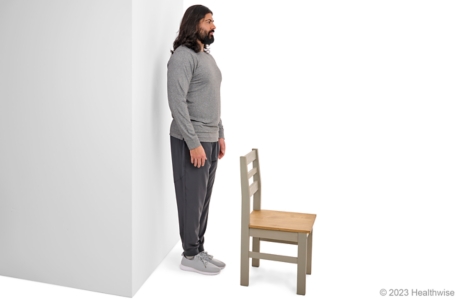
- Stand with a chair in front of you and a wall behind you. If you begin to fall, you can use them for support.
- Stand with your feet together and your arms at your side.
- Hold this position for 30 seconds.
Do this exercise twice a day. Try to progress to doing it with your eyes closed.
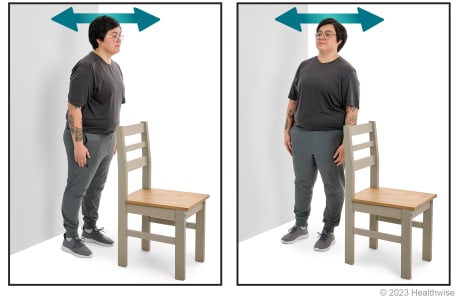
- Stand with a chair in front of you and a wall behind you. If you begin to fall, you can use them for support.
- Stand with your feet shoulder-width apart and your arms at your side.
- Sway forward to backward.To do this, gently lean forward and then backward so that your weight shifts to your toes and then to your heels. Do not lift your toes or heels.
- Be sure that your shoulders and hips move together. Do not bend at your hips.
- Slowly increase how far you can sway forward and backward without taking a step.
- Repeat the forward-to-backward sway 20 times.
- Next, turn to one side and then sway from side to side.To do this, gently lean to the right and then to the left so that your weight shifts from your right foot to your left foot. Do not lift your toes or heels.
- Be sure that your shoulders and hips move together. Do not bend at your hips.
- Slowly increase how far you can sway to the right and the left without taking a step.
- Repeat the side-to-side sway 20 times.
Do this exercise 2 times a day. Try to progress to doing it 30 times and then with your eyes closed.
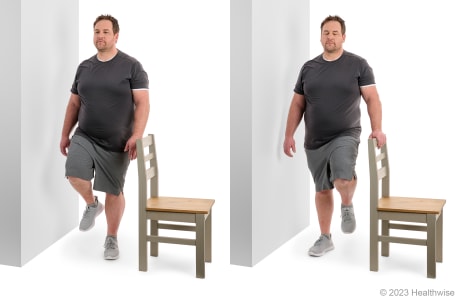
- Stand next to a chair or counter. You can use this for support if you begin to fall. You can also stand with your back to a corner and use the walls if you need support.
- Stand with your feet slightly apart (as you normally stand) and your arms at your side.
- March in place, lifting each knee high toward the ceiling.
- Do this 20 times.
Do this exercise twice a day. Try to progress to doing this 30 times and then with your eyes closed.
Harder (level 2) exercises
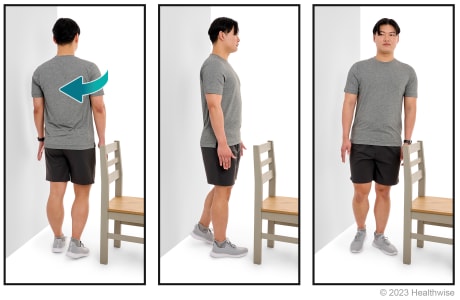
- Stand with a chair in front of you and a wall behind you. If you begin to fall, you may use them for support.
- Stand with your feet slightly apart (as you normally stand) and your arms at your side.
- Turn one half-circle (180 degrees).
- Stop for 10 seconds or until any dizziness goes away.
- Do this 5 times. The first time you do this exercise, turn to the right, and the second time, turn to the left. Which makes you dizzier? Then concentrate on turning in the direction that makes you feel dizzier.
Do this exercise twice a day. Try to progress to being able to turn a full circle with your eyes shut.
When it is easy for you to do this exercise, try doing it away from the wall. You can also try doing the exercise on a mat or other soft surface.
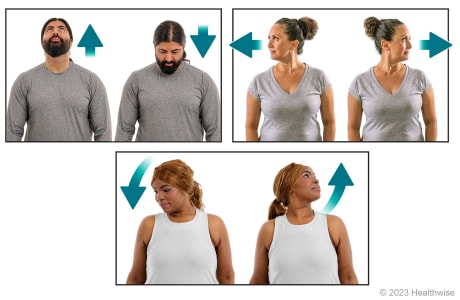
- Stand with a chair in front of you and a wall behind you. If you begin to fall, you can use them for support. Now stand with your feet together and your arms at your side.
- Move your head up and down 10 times.
- Move your head side to side 10 times.
- Move your head diagonally up and down 10 times.
- Move your head diagonally up and down 10 times on the other side.
Do this exercise 2 times a day. Try to progress to doing this 15 to 20 times for each head movement. Then try to do this with your eyes closed.
Current as of: October 27, 2024
Author: Ignite Healthwise, LLC Staff
Clinical Review Board
All Healthwise education is reviewed by a team that includes physicians, nurses, advanced practitioners, registered dieticians, and other healthcare professionals.
This information does not replace the advice of a doctor. Ignite Healthwise, LLC, disclaims any warranty or liability for your use of this information. Your use of this information means that you agree to the Terms of Use. Learn how we develop our content.
To learn more about Ignite Healthwise, LLC, visit webmdignite.com.
© 2024-2025 Ignite Healthwise, LLC.
This information does not replace the advice of a doctor. Ignite Healthwise, LLC, disclaims any warranty or liability for your use of this information. Your use of this information means that you agree to the Terms of Use. Learn how we develop our content.

